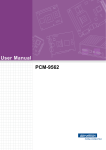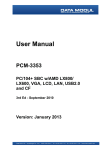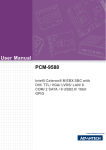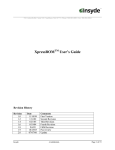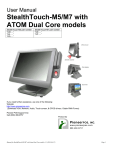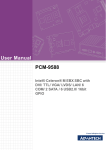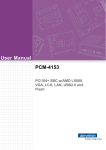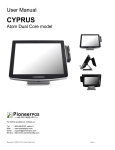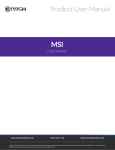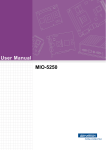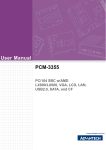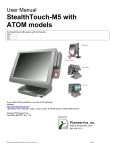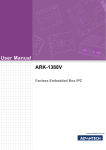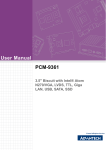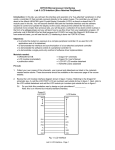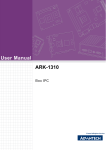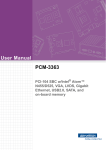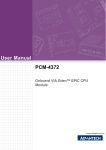Download User Manual PCM-4373
Transcript
User Manual PCM-4373 Copyright The documentation and the software included with this product are copyrighted 2008 by Advantech Co., Ltd. All rights are reserved. Advantech Co., Ltd. reserves the right to make improvements in the products described in this manual at any time without notice. No part of this manual may be reproduced, copied, translated or transmitted in any form or by any means without the prior written permission of Advantech Co., Ltd. Information provided in this manual is intended to be accurate and reliable. However, Advantech Co., Ltd. assumes no responsibility for its use, nor for any infringements of the rights of third parties, which may result from its use. Acknowledgements Award is a trademark of Award Software International, Inc. VIA is a trademark of VIA Technologies, Inc. IBM, PC/AT, PS/2 and VGA are trademarks of International Business Machines Corporation. Intel and Pentium are trademarks of Intel Corporation. Microsoft Windows® is a registered trademark of Microsoft Corp. RTL is a trademark of Realtek Semi-Conductor Co., Ltd. ESS is a trademark of ESS Technology, Inc. UMC is a trademark of United Microelectronics Corporation. SMI is a trademark of Silicon Motion, Inc. Creative is a trademark of Creative Technology LTD. CHRONTEL is a trademark of Chrontel Inc. All other product names or trademarks are properties of their respective owners. PCM-4373 User Manual Part No. 2006437310 Edition 1 Printed in Taiwan December 2008 ii Product Warranty (2 years) Advantech warrants to you, the original purchaser, that each of its products will be free from defects in materials and workmanship for two years from the date of purchase. This warranty does not apply to any products which have been repaired or altered by persons other than repair personnel authorized by Advantech, or which have been subject to misuse, abuse, accident or improper installation. Advantech assumes no liability under the terms of this warranty as a consequence of such events. Because of Advantech’s high quality-control standards and rigorous testing, most of our customers never need to use our repair service. If an Advantech product is defective, it will be repaired or replaced at no charge during the warranty period. For outof-warranty repairs, you will be billed according to the cost of replacement materials, service time and freight. Please consult your dealer for more details. If you think you have a defective product, follow these steps: 1. Collect all the information about the problem encountered. (For example, CPU speed, Advantech products used, other hardware and software used, etc.) Note anything abnormal and list any onscreen messages you get when the problem occurs. 2. Call your dealer and describe the problem. Please have your manual, product, and any helpful information readily available. 3. If your product is diagnosed as defective, obtain an RMA (return merchandise authorization) number from your dealer. This allows us to process your return more quickly. 4. Carefully pack the defective product, a fully-completed Repair and Replacement Order Card and a photocopy proof of purchase date (such as your sales receipt) in a shippable container. A product returned without proof of the purchase date is not eligible for warranty service. 5. Write the RMA number visibly on the outside of the package and ship it prepaid to your dealer. Declaration of Conformity FCC Class A Note: This equipment has been tested and found to comply with the limits for a Class A digital device, pursuant to part 15 of the FCC Rules. These limits are designed to provide reasonable protection against harmful interference when the equipment is operated in a commercial environment. This equipment generates, uses, and can radiate radio frequency energy and, if not installed and used in accordance with the instruction manual, may cause harmful interference to radio communications. Operation of this equipment in a residential area is likely to cause harmful interference in which case the user will be required to correct the interference at his own expense. iii PCM-4373 User Manual Technical Support and Assistance 1. 2. Visit the Advantech web site at www.advantech.com/support where you can find the latest information about the product. Contact your distributor, sales representative, or Advantech's customer service center for technical support if you need additional assistance. Please have the following information ready before you call: – Product name and serial number – Description of your peripheral attachments – Description of your software (operating system, version, application software, etc.) – A complete description of the problem – The exact wording of any error messages Packing List Before setting up the system, check that the items listed below are included and in good condition. If any item does not accord with the table, please contact your dealer immediately. ! 1 x PCM-4373 SBC ! 1 x Startup manual ! 1 x Utility CD ! 1 x mini jumper pack (PN: 9689000002) ! 1 x CABLE USB*2/10-2.0 mm 29 cm (PN: 1700001267) ! 1 x FLAT Cable 50P 20 cm 3Com & LPT 1.27 mm to D-sub (PN: 1700002034) ! 1 x Cable 20P/10P EPIC ATX POWER 10 cm (PN: 1700002055) ! 1 x Cable 2*4P/10P EPIC AT POWER 15 cm (PN: 1700003931) ! 1 x CABLE 6P-6P-6P 20 cm PS/2 KB & MOUSE 20cm (PN: 1700060202) ! 2 x CABLE SERIAL ATA 7P/7P 30 cm (PN: 1700008894) ! 1 x Audio Cable IDC-10P 2.0 mm 15 cm (PN: 1700008902) Ordering Information PCM-4373L-J0A1E AMD GX3 w/ 1 LAN/LVDS/0 GPIO /4 COM/4 USB/2 SATA, AMD Lx800 chipset, 128 KB L2 cache, 1 x 10/100 LAN, 24 bit TTL, 1 x VGA, 4 x USB2.0, 2 x RS-232, 2 x RS-232/422/485, 1 x LPT, 1 x CF, 2 x SATA, 1 x PC/104 Plus (0 ~ 60° C), passive thermal solution PCM-4373F-J0A1E Base PCM-4373L-J0A1E,w/2 LAN/16 GPIO/6 COM/Audio AMD Lx800 chipset, 128 KB L2 cache, 2 x 10/100 LAN, 18 bit LVDS, 1 x VGA, 4 x USB2.0, 4 x RS-232, 2 x RS-232/422/485, 16 bit GPIO, 1 x LPT, 1 x CF, 2 x SATA, Audio, 1 x PC/104 Plus (0 ~ 60° C), passive thermal solution Optional Accessories 1701200220 Cable for 2COM ports 20P 22 cm 1703150102 Wire BIG4P/Series ATA power 15P 10 cm module 1703040157 Wire RS-422/485 4P to D-SUB 15 cm PCM-4373 User Manual iv Contents Chapter Chapter 1 General Introduction ...........................1 1.1 1.2 1.3 Introduction ............................................................................................... 2 Specifications ............................................................................................ 2 Chipset ...................................................................................................... 3 1.3.1 Functional Specification ................................................................ 3 1.3.2 Mechanical Specification .............................................................. 6 1.3.3 Electrical Specification .................................................................. 7 1.3.4 Environmental Specification.......................................................... 8 2 H/W installation....................................9 2.1 2.3 Jumpers .................................................................................................. 10 2.1.1 Jumper List ................................................................................. 10 2.1.2 Jumper Settings .......................................................................... 10 2.1.3 Jumper Description ..................................................................... 12 Connectors.............................................................................................. 13 2.2.1 Connector List............................................................................. 13 2.2.2 Connector Settings ..................................................................... 14 Mechanical .............................................................................................. 33 2.3.1 Jumper and Connector Locations ............................................... 33 Figure 2.1 PCM-4373 board layout (Component Side) ............. 33 Figure 2.2 PCM-4373 board layout (Solder Side)...................... 33 2.3.2 Board Dimensions....................................................................... 34 Figure 2.3 Board dimension layout (Component side) .............. 34 Figure 2.4 Board dimension layout (Solder side)....................... 35 Figure 2.5 Coast line layout ....................................................... 36 3 BIOS Operation ..................................37 3.1 3.2 BIOS Introduction.................................................................................... 38 BIOS Setup ............................................................................................. 38 3.2.1 Main Menu .................................................................................. 39 3.2.2 Standard CMOS Features .......................................................... 40 3.2.3 Advanced BIOS Features ........................................................... 41 3.2.4 Advanced Chipset Features........................................................ 42 3.2.5 Integrated Peripherals................................................................. 44 3.2.6 Power Management Setup ......................................................... 46 3.2.7 PnP/PCI Configurations .............................................................. 48 3.2.8 PC Health Status ........................................................................ 49 3.2.9 Load Optimized Defaults............................................................. 50 3.2.10 Set Password.............................................................................. 50 3.2.11 Save & Exit Setup ....................................................................... 52 3.2.12 Quit Without Saving .................................................................... 52 4 S/W Installation.................................53 4.1 4.2 S/W Introduction...................................................................................... 54 Driver Installation .................................................................................... 54 4.2.1 Windows XP Professional........................................................... 54 4.2.2 Other OS..................................................................................... 54 SUSI Application Library ......................................................................... 55 4.3.1 SUSI Introduction........................................................................ 55 2.2 Chapter Chapter 4.3 v PCM-4373 User Manual 4.3.2 4.3.3 4.3.4 Chapter SUSI Functions........................................................................... 55 SUSI Installation ......................................................................... 56 SUSI Sample Programs.............................................................. 58 5 Extension I/O Installation ................. 67 5.1 SODIMM ................................................................................................. 68 Figure 5.1 SODIMM................................................................... 68 PC-104 Plus............................................................................................ 68 Figure 5.2 PC-104 Plus ............................................................. 68 5.2 Appendix A Programming the GPIO & Watchdog Timer69 A.1 A.2 Programming the Watchdog Timer ........................................................ 70 GPIO Sample Code ................................................................................ 71 Appendix B System Assignments........................ 83 B.1 System I/O Ports..................................................................................... 84 Table B.1: System I/O Ports ...................................................... 84 1st MB memory map............................................................................... 85 Table B.2: 1st MB Memory Map ................................................ 85 DMA Channel Assignments .................................................................... 85 Table B.3: DMA Channel Assignments ..................................... 85 Interrupt Assignments ............................................................................. 86 Table B.4: Interrupt Assignments .............................................. 86 B.2 B.3 B.4 Appendix C 2nd RTC ............................................. 87 C.1 2nd RTC.................................................................................................. 88 PCM-4373 User Manual vi Chapter 1 1 General Introduction This chapter gives background information on PCM-4373. Sections include: ! Introduction ! Specifications 1.1 Introduction ! EPIC form factor (115 mm x 165 mm) ! ! ! ! ! ! ! ! ! AMD GeodeTM LX800 processor, up to 500 MHz Total system power consumption under 10W. Up to 1 GB DDR SDRAM (supports FSB 266/333/400 MHz),1 x 200-pin Display Combination: CRT+ 18 bit LVDS or CRT+ 24bit TTL Dual 10/100 Mbps Ethernet Supports ATX/ AT power modes (5 V only bootup) Supports 1 x PC/104 Plus (PCI +16 bit ISA) Supports 4 x USB 2.0, 2 x SATA Supports 6 x COM (4 x RS232, 2 x RS232/422/485) or 4 x COM (2 x RS232, 2 x RS232/422/485) Optional 16-bit GPIO and AC97 audio supported (PCM-4373F-J0A1E) ! 1.2 Specifications General ! CPU: AMD Geode™ LX800 processor, up to 500 MHz ! 2nd Cache Memory: 128 KB ! System Chipset: AMD Geode™ LX800 + CS5536 ! BIOS: Award 4Mb LPC BIOS ! System Memory: 1 x 200-pin SODIMM DDR FSB 266/333/400, up to 4GB ! Power Management: APM1.2, ACPI support ! Watchdog Timer: 255-level interval timer, setup by software, Super I/O integrated, SMSC Controller ! Expansion Interface: Supports 1 x PC/104 Plus (PCI +16 bit ISA) ! Battery: Lithium 3 V / 196 mAH PCM-4373 User Manual 2 1.3.1 Functional Specification 1.3.1.1 Processor ! ! ! Supports AMD GeodeTM LX800 processor, up to 500 MHz 128 KB L2 cache Supports DDR 266, 333 and 400 MHz North Bridge Controller Hub Display AMD Geode LX800 VGA TTL (24 bit) LVDS (18 bit) Choose National Semiconductor DS90CF363B (Advantech P/ N#1410000626)) for 18bit single channel LVDS TTL and LVDS can display using same BIOS Features CRT resolutions supported: Supports up to 1920x1440x32 bpp at 85 Hz Supports up to 1600x1200x32 bpp at 100 Hz LVDS resolutions supported: Supports VGA, SVGA, XGA and Dual Pixel SXGA. TTL supported: Standard Definition (SD) resolution for Video Output Port (VOP): 720 x 482 at 59.94 Hz interlaced for NTSC 768 x 576 at 50 Hz interlaced for PAL High Definition (HD) resolution for Video Output Port (VOP): Up to 1920 x 1080 at 30 Hz interlaced (1080i HD) (74.25 MHz) Up to 1280 x 720 at 60 Hz progressive (720p HD) (74.25 MHz) Supports down to 7.652 MHz Dot Clock (320 x 240 QVGA) Hardware supported 48 x 64 32-bit cursor with alpha blending PCI Compliant PCI 2.2 compliant 3.3 V signaling and 3.3 V I/Os 33 MHz operation 32-bit interface Supports virtual PCI headers for GeodeLink devices Security Block Serial EEPROM interface for 2K bit unique ID and AES (Advanced Encryption Standard) hidden key storage (EEPROM optional inside package) Electronic Code Book (ECB) or Cipher Block Chaining (CBC)128-bit AES hardware support True random number generator (TRNG) 3 PCM-4373 User Manual General Introduction 1.3.1.2 Chipset (LX800) Chapter 1 1.3 Chipset 1.3.1.3 Chipset (CS5536) South Bridge Controller Hub AMD CS5536 Package 208-Terminal PBGA (plastic ball grid array) package with internal heatspreader AMD Geode CS5536 supports. GeodeLink PCI Interface (South Bridge) Provides a PCI interface for GeodeLink Devices: — PCI specification v2.2 compliant — 32-Bit, 33 MHz operation — Capable of handling in-bound transactions immediately after reset - no setup — Mapping of PCI virtual configuration space to MSR space is done completely in Virtual System Architecture (VSA) code — Serialized processor control interface AMD Geode CS5536 supports. LPC (Low Pin Count) Interface — Based on Intel LPC Interface specification v1.0 — Serial IRQ support — Serial DMA support (8-bit only) — Boot source typically off external LPC — Supports firmware hub protocol — External bus masters not supported PCI Bus PCI masters 10/100 LAN1 (RTL8100CL-LF) 10/100 LAN2 (RTL8100CL-LF) Other Feature 4 USB 2.0 ports 2 Serial ATA (150MB/s) (Not support RAID function) Power Management LPC interface to Flash BIOS 6 COM ports, 4 x COM: RS-232; 2 x COM : RS-232/422/485 Signal (Support Auto flow control) (Support via SMSC 3114 + Fintek 81216DG) (Limitation: Under CE can support 6 COM ports but need to choose close one IRQ device) PCM-4373 User Manual 4 Chapter 1 1.3.1.4 Others (Chipset) Display Chipset AMD Geode LX800 Dual independent display NA AMD Geode LX800 supports. Supports video scaling, mixing and VOP Graphics/video alpha blending and color key muxing Digital VOP (SD and HD) or TFT outputs VESA 1.1, 2.0 and BT.601 24-bit (out only), BT.656 compliant Integrated Dot Clock PLL with up to 350 MHz clock Integrated 3 x 8-bit DAC with up to 350 MHz sampling Analog CRT DAC interface support VGA CRT resolutions supported: Supports up to 1920 x 1440 x 32 bpp at 85 Hz Supports up to 1600 x 1200 x 32 bpp at 100 Hz LVDS 18-bit (convert from TTL via NS DS90CF363B) 18 to 68 MHz shift clock support Supports VGA, SVGA, XGA and Dual Pixel SXGA. Compatible with TIA/EIA-644 LVDS standard TTL It supports panels up to a 24-bit interface and up to 1600 x 1200 resolution. Internal Graphics Features 2D Graphics Processor High performance 2D graphics controller Alpha BLT Microsoft Windows GDI GUI acceleration: — Hardware support for all Microsoft RDP codes Command buffer interface for asynchronous BLTs Second pattern channel support Hardware screen rotation New features added to the Graphics Processor include: Command buffer interface Hardware accelerated rotation BLTs Color depth conversion Paletized color Full 8x8 color pattern buffer Separate base addresses for all channels Monochrome inversion LAN Chipset LAN 1 / LAN 2: Realtek RTL8100CL-LF IEEE Compliant full compliance with IEEE 802.3 u 100BASE-T and IEEE 802.3 x full duplex flow control. 32-bit PCI Ethernet controller. LAN LED LED1: Green for 10M/100M LAN LED2: Off for Link, flash for active, Disable LAN through BIOS Yes Wake on LAN Yes Boot from LAN Yes LED connector Yes 5 PCM-4373 User Manual General Introduction Video Processor & Integrated Analog Display Audio Chipset AC97 Audio Codec ALC203 Rear panel output Line-In, Line-out, Mic-In Amplifier NA Hardware Monitor Chipset LPC I/O for onboard alarm SMSC3114 Temperature CPU Temperature Voltage 2.5 V, Vcore, 12 V, 5 V Super I/O Chipset SMSC3114 Fan speed monitor Yes Temperature Yes Features LPC interface 4 full function serial ports watch dog timer Hardware Monitoring – Thermal Sensing :2 external, 1 internal – (7) Voltage Monitoring Infrared port: IrDA 1.0 compliant 1.3.2 Mechanical Specification 1.3.2.1 Dimension (mm) 115 mm (L) x 165 mm (W) (4.5" x 6.5") 1.3.2.2 Height on Top (mm) 9.8 mm (Heatsink) 1.3.2.3 Height on Bottom (mm) 9.2 mm (SODIMM Socket) 1.3.2.4 Cooler Dimension (mm) 39.6 x 39.5 x 9.8 mm (Heatsink) 1.3.2.5 Weight (g) with Cooler 110 g PCM-4373 User Manual 6 1.3.3.1 Power Supply Voltage Power Type Power AT/ATX ATX: +5 V ± 5%,+5 Vsb to work (±12 V ± 5% optional for LCD inverter and add on card.) Power Supply Voltage AT: +5 V ± 5% (±12 V ± 5% optional for LCD inverter and add on card.) APM, ACPI Battery Lithium 3 V/196 mAH General Introduction Power Management 1.3.3.2 Power Supply Current Test Conditions : OS - WindowsXP SP2 Add-in Card - None CF Card - None MiniPCI Card - None HDD - 160GB SATA *1 BIOS - 4373V111.bin KeyBoard/Mouse - USB or PS/2 Interface Display - CRT Memory 512MB Apacer DDR 400 64MB X 8 ATX CPU AMD LX800 Status +V5 +V12 +V5SB 0.02 A BIOS Picture 1.52 A Unused 0.02 A DOS Idle 1.50 A Unused 0.02 A Win Idle 1.45 A Unused 0.02 A Win HCT12.0 1.72 Unused 0.02 A +V5 maximum current: 1.85 A AT CPU AMD LX800 +V5 +V12 BIOS Picture 1.52 A Unused DOS Idle 1.50 A Unused Win Idle 1.45 A Unused Win HCT12.0 1.72 Unused Status +V5 maximum current: 1.9 A 1.3.3.3 RTC Battery ! Typical Voltage: 3.0 V ! Normal discharge capacity: 196 mAh3 7 Chapter 1 1.3.3 Electrical Specification PCM-4373 User Manual 1.3.4 Environmental Specification 1.3.4.1 Operating Temperature The AMD® CPU LX800 is specified for proper operation temperature range of 40° C ~ +85° C. The AMD CS5536 I/O Controller case temperature runs at a maximum of 95° C. Operating temperature: 0 ~ 60° C (32 ~ 140° F) 1.3.4.2 Operating Humidity Operating humidity: 0% ~ 90% relative humidity, non-condensing 1.3.4.3 Storage Temperature Standard products (0 ~ 60° C) Storage temperature: -20 ~ 70° C 1.3.4.4 Storage Relative Humidity Standard products (0 ~ 60° C) Relative humidity: 95% @ 60° C Phoenix products (-20 ~ 80° C) Relative humidity: 95% @ 60° C Platinum Phoenix products (-40 ~ 85° C) Relative humidity: 95% @ 60° C PCM-4373 User Manual 8 Chapter 2 2 H/W installation This chapter explains the setup procedures of the PCM-4373 hardware, including instructions on setting jumpers and connecting peripherals, switches, indicators and mechanical drawings.Be sure to read all safety precautions before you begin the installation procedure. Sections include: ! Jumpers ! Connectors ! Mechanical 2.1 Jumpers 2.1.1 Jumper List J1 AT Select J2 DOTREF Select J3 LVDS POWER Select J4 CMOS Clear J5 COM1 Mode Select J6 COM2 Mode Select J7 PCI VIO Select J9 IrDA/COM2 Select 2.1.2 Jumper Settings J1 AT select Part Number 1653002101 Footprint JH2X1V-2M Description PIN HEADER 2*1P 180D (M) 2.0 mm DIP SQUARE W/O Pb Setting Function (1-2) AT Enable J2 DOTREF Select Part Number 1653002101 Footprint JH2X1V-2M Description PIN HEADER 2*1P 180D (M) 2.0 mm DIP SQUARE W/O Pb Setting Function (1-2) External NL Internal J3 LVDS Power Select Part Number 1653003101 Footprint JH3X1V-2M Description PIN HEADER 3*1P 180D (M) 2.0 mm DIP SQUARE W/O Pb Setting Function (1-2) 5V (2-3) 3.3 V (Default) PCM-4373 User Manual 10 1653003101 Footprint JH3X1V-2M Description PIN HEADER 3*1P 180D (M) 2.0 mm DIP SQUARE W/O Pb Setting Function (1-2) Disable (Default) (2-3) Clear J5 COM1 Mode Select Part Number 1653003260 Footprint JH3X2S-2M Description PIN HEADER 3*2P 180D (M) 2.0 mm DIP SQUARE W/O Pb Setting Function (1-2) 232 (Default) (3-4) 485 (5-6) 422 J6 COM2 Mode Select Part Number 1653003260 Footprint JH3X2S-2M Description PIN HEADER 3*2P 180D (M) 2.0 mm DIP SQUARE W/O Pb Setting Function (1-2) 232 (Default) (3-4) 485 (5-6) 422 NL IrDA J7 PCI VIO Select Part Number 1653003101 Footprint JH3X1V-2M Description PIN HEADER 3*1P 180D (M) 2.0 mm DIP SQUARE W/O Pb Setting Function (1-2) 5 V (Default) (2-3) 3.3 V J9 IrDA/COM2 Select Part Number 1653002101 Footprint JH3X1V-2M Description PIN HEADER 3*1P 180D (M) 2.0 mm DIP SQUARE W/O Pb Setting Function (1-2) COM2 NL IrDA 11 PCM-4373 User Manual H/W installation CMOS Clear Part Number Chapter 2 J4 2.1.3 Jumper Description Cards can be configured by setting jumpers. A jumper is a metal bridge used to close an electric circuit. It consists of two metal pins and a small metal clip (often protected by a plastic cover) that slides over the pins to connect them. To close a jumper, you connect the pins with the clip. To open a jumper, you remove the clip. Sometimes a jumper will have three pins, labeled 1, 2 and 3. In this case you would connect either pins 1 and 2, or 2 and 3. The jumper settings are schematically depicted in this manual as follows. Warning! To avoid damaging the computer, always turn off the power supply before setting jumpers. Clear CMOS. Before turning on the power supply, set the jumper back to 3.0 V Battery On. PCM-4373 User Manual 12 Chapter 2 2.2 Connectors 2.2.1 Connector List POWER connector CN3 DDR SO-DIMM CN5 FAN connector CN7 GPIO1 connector CN8 LAN1(RJ45) CN9 LAN2(RJ45) CN11 Compact Flash connector CN13 HD & Power LED CN14 Internal LVDS connector CN16 CRT connector CN18 USB0/1 CN19 KB/MS connector CN20 USB2/3 CN21 COM1 CN22 AUDIO connector CN25 PCI-104 connector CN26 COM1 RS422/485 connector CN30 COM2/3/4 & LPT CN32 SATA1 connector CN33 SATA2 connector CN36 TTL LCD connector CN37 SMBUS Connector CN38 Panel Inverter Power CN39 ATX POWER Button CN41 COM5,6 CN43 COM2 RS422/485 connector CN44 ISA -V5 Connector CN46 GPIO2 Connector CN53 BATTERY connector CN54 IrDA Connector 13 H/W installation CN1 PCM-4373 User Manual 2.2.2 Connector Settings CN1: Power connectors Main power connector, +3.3 V, +5 V, +12 V, -12 V PCM-4373 can support both ATX and AT power supply and it can use different power cable to do the choice. 1. ATX power supply: you need to use ATX power cable (PN: 1700002055 Cable 20P/10P EPIC ATX POWER 10CM) 2. AT power supply: you need to use AT power cable (PN: 1700003931 AT Power Cable 2*4P/10P EPIC AT POWER 15cm) CN1 connector is 10-Pin power connector and it allows you to connect to an ATX or AT power supply by different power cable. CN1 Power Connector Part Number 1655000042 Footprint ATXCON-2X5-42-1 Description WAFER 4.2 mm 10P 180D(M) DIP 4200-WS-A1-2*5 Pin Pin Name Signal Type Signal Level 1 SIO_PSON# IN +5 V 2 GND 3 GND 4 +V12 PWR +12 V 5 NC PWR +3.3 V 6 +V5SB_ATX PWR +5 V 7 +V5 PWR +5 V 8 +V5 PWR +5 V 9 -V12 PWR -12 V 10 GND PCM-4373 User Manual 14 DDR SO-DIMM Part Number 1651000705 Footprint SODIMM_200P_ASOA426-EASN-4F Description SKT DDR2-SODIMM 200P H=9.2 SMD AS0A426-NASN-7F CN5: Fan connector Provides power supply +5 V for CPU cooling fan, and fan speed detects signal input. CN5 FAN connector Part Number 1655303020 Footprint WHL3V-2M Description Wafer 2.00mm 3P 180D(M) DIP W/LOCK 22-27-2031 Pin Pin Name Signal Type 1 FAN0_IO OUT 2 +V5 PWR 3 GND 15 Signal Level +5 V PCM-4373 User Manual H/W installation CN3 Chapter 2 CN3: DDR2 SO-DIMM A SO-DIMM, or small outline dual in-line memory module, is a type of computer memory built using integrated circuits.PCM-4373 has 1 x 200 pin SO-DIMM and can support memory size up to 1 GB. CN7: GPIO1 (General Purpose Input Output) PCM4373 supports 16-bit GPIO via CN7 and CN46. CN7 GPIO1 connector Part Number 1653000383 Footprint JH5X2S-2M21N22050 Description PIN HEADER 5*2P 90D(M) 2.0 mm SMD WO/Pb Pin Pin Name Signal Type Signal Level 1 +5 V PWR +5 V 2 GPIO4 I/O +5 V 3 GPIO0 I/O +5 V 4 GPIO5 I/O +5 V 5 GPIO1 I/O +5 V 6 GPIO6 I/O +5 V 7 GPIO2 I/O +5 V 8 GPIO7 I/O +5 V 9 GPIO3 I/O +5 V 10 GND CN8: Ethernet connector The board is equipped with 2 high performance Ethernet interface which use RJ45 connector. One is CN8 and another one is CN9. CN8 LAN1(RJ45+1G Transformer) Part Number 1652000147 Footprint RJ45X10-LED-1AX9 Description Phone Jack RJ45 14P 90D (F) W/Xfam P26@P07-1AM9 Pin Pin Name Signal Type Signal Level 1 LAN1_TX+ OUT Analog 2 LAN1_TX- OUT Analog 3 LAN1_RX+ IN Analog 4 LAN1_RX- IN Analog 5 +V3.3_LAN1 PWR 6 NC 7 NC 8 NC PCM-4373 User Manual 16 Chapter 2 CN9: Ethernet Connector CN9 LAN2(RJ45+1G Transformer) Part Number 1652000174 Footprint RJ45+XFMR+LED Description Phone Jack RJ45 14P 90D (F) W/Xfam P26@P07-1AM9 Pin Pin Name 1 LAN2_TX+ OUT Analog 2 LAN2_TX- OUT Analog 3 LAN2_RX+ IN Analog 4 LAN2_RX- IN Analog 5 +V3.3_LAN2 PWR 6 NC 7 NC 8 NC Signal Type Signal Level CN11: Compact Flash connector The board provides a CompactFlash. card type I/II socket and the CompactFlash use master IDE channel. CN11 Compact Flash connector Part Number 1653002086 Footprint SPEED_N016-0140104 Description CF HEADER 50P 90D (M) 1.27 mm SMD Type2 Standoff=2 17 PCM-4373 User Manual H/W installation The board is equipped with 2 high performance Ethernet interface which use RJ45 connector. One is CN9 and another one is CN8. CN13: HD and Power LED 1 2 3 4 CN13 is an indication LED connector for HD and power. CN13 HD & Power LED Part Number 1653004101 Footprint JH4X1V-2M Description PIN HEADER 4*1P 180D (M) SQUARE 2.0 mm Pin Pin Name Signal Type Signal Level 1 +VCC_1 PWR +5 V 2 GND 3 +VCC_2 PWR +5 V 4 HD_LED OUT +5 V CN14: LVDS connector CN14 is LVDS (Low Voltage Differential Signal) connector. You can connect to 18 bit LVDS LCD panel via CN14. CN14 Internal LVDS Connector Part Number 1653910261 Footprint SPH10X2 Description *CONN. 20P 90D 1.25 mm SMD WO/Pb DF13-40DP-1.25 V Pin Pin Name 1 GND 2 GND 3 LVDS0_D0+ 4 NC 5 LVDS0_D0- 6 NC 7 LVDS0_D1+ 8 NC 9 LVDS0_D1- 10 NC 11 LVDS0_D2+ 12 NC 13 LVDS0_D2- 14 NC 15 LVDS0_CLK+ 16 NC 17 LVDS0_CLK- Signal Type Signal Level OUT LVDS OUT LVDS OUT LVDS OUT LVDS OUT LVDS OUT LVDS OUT LVDS OUT LVDS 18 NC 19 VCC_LVDSB PWR +5 V/+3.3 V 20 VCC_LVDSA PWR +5 V/+3.3 V PCM-4373 User Manual 18 Chapter 2 CN16: VGA connector The DB15-pin female connector is provided for video monitors. CRT Connector Part Number 1654000055 Footprint DBVGA-VF5MS Description D-SUB Conn. 15P 90D (F) DIP 070242FR015S200ZU Pin Pin Name Signal Type Signal Level 1 VGA_z_R OUT Analog 2 VGA_z_G OUT Analog 3 VGA_z_B OUT Analog 4 NC 5 GND GND 6 GND GND 7 GND GND 8 GND GND 9 +V5_b_VGA PWR 10 GND GND 11 NC 12 VGA_y_DDAT OUT +5 V 13 VGA_y_HS OUT +5 V 14 VGA_y_VS OUT +5 V 15 VGA_y_DCLK OUT +5 V 19 +5 V PCM-4373 User Manual H/W installation CN16 CN18: USB connectors The board provides up to 4 x USB (Universal Serial Bus) ports. You can use it by CN18 and CN20. CN18 is a 2 x USB type A connector and CN20 is a pin header type. PCM-4373 USB ports gives complete Plug and Play, and hot attach/detach for up to 127 external devices and comply with USB specification Rev. 2.0 which supports 480Mbps transfer rate, and are fuse protected. CN18 USB0/1 Part Number 1654908100 Footprint USBX2-V Description USB Conn. DUAL port 8P 90D (M) Black PC99 Pin Pin Name Signal Type Signal Level 1 +V5DUAL_USB0 PWR +5 V 2 USB0_z_P- I/O 3 USB0_z_P+ I/O 4 GND 5 +V5DUAL_USB0 PWR 6 USB1_z_P- I/O 7 USB1_z_P+ I/O 8 GND 9 GND 10 GND 11 GND 12 GND PCM-4373 User Manual 20 +5 V This connector is for PS/2 keyboard and mouse. You need a one to two connector cable (Part number: 1700060202) for keyboard and mouse. KB/MS Connector Part Number 1654003199 Footprint CONTEK_MQN3261F 1G400 Description MINIDIN 6P Short body W/Shielding90D (F) DIP Pin Pin Name Signal Type Signal Level 1 KB_z_DAT# I/O +5 V 2 MS_z_DAT# I/O +5 V 3 GND 4 +V5DUAL_PS2 PWR +5 V 5 KB_z_CLK# I/O +5 V 6 MS_z_CLK# I/O +5 V CN20: USB connectors CN20 is a pin header type for 2 x USB 2.0 ports. PCM-4373 USB ports gives complete Plug and Play, and hot attach/detach for up to 127 external devices and comply with USB specification Rev. 2.0 which supports 480Mbps transfer rate, and are fuse protected. CN20 USB2/3 Part Number 1653205261 Footprint HD_5x2P_79_BOX_N 10 Description PIN HEADER 5x2P 180D (M) 2.0 mm SMD IDIOT-PROOF Pin Pin Name Signal Type Signal Level 1 +V5DUAL_USB1 PWR +5 V 2 +V5DUAL_USB1 PWR +5 V 3 USB2_z_P- I/O 4 USB3_z_P- I/O 5 USB2_z_P+ I/O 6 USB3_z_P+ I/O 7 GND 8 GND 9 GND 21 PCM-4373 User Manual H/W installation CN19 Chapter 2 CN19: Keyboard and PS/2 mouse connector CN21: COM1 port connector for RS232 PCM-4373 provides 6 serial communication ports. CN21 is one of the serial communication ports. CN21 is 9 pin D-shell connector used for the RS 232 serial port. CN21 COM1 Part Number 1654000056 Footprint DBCOM-VM5MS Description D-SUB CON. 9P 90D (M) DIP 070241MR009S200ZU SUYIN Pin Pin Name Signal Type Signal Level 1 COM0_z_DCD# IN +5 V 2 COM0_z_RXD IN +5 V 3 COM0_z_TXD OUT +5 V 4 COM0_z_DTR# I/O +5 V 5 GND 6 COM0_z_DSR# IN +5 V 7 COM0_z_RTS# I/O +5 V 8 COM0_z_CTS# IN +5 V 9 COM0_z_RI IN +5 V CN22: Audio interface Audio Port Connectors CN27 is a 5 x 2P box header and it is for audio interface. CN22 AUDIO connector Part Number 1653205260 Footprint BH5x2P-S2.00 Description BOX HEADER SMD 5*2 180D (M) 2.0 mm Pin Pin Name Signal Type Signal Level 1 LINEOUT_R Out Analog 2 LINEIN_R IN Analog 3 AGND GND 4 AGND GND 5 LINEOUT_L Out Analog 6 LINEIN_L IN Analog 7 AGND GND PCM-4373 User Manual 22 AGND 9 NC 10 MIC1_L GND IN Analog CN25: PCI-104 connector CN25 is a PCI104 connector. PCI-104 form factor includes the PCI connector. It is intended for industrial embedded computing environments where applications depend on reliable data acquisition. PCI-104 Connector Part Number 1653130428 Footprint PC104-PCI-PLUS Description PCB SKT 30*4 180D (F)PC/104+ SOLDER WO/Pb EPT CN26: COM1 for RS422/485 CN26 is a 1 x 4P connector for RS422/485. CN26 COM1 RS-422/485 connector Part Number 1653004101 Footprint JH4X1V-2M Description PIN HEADER 4*1P 180D (M) SQUARE 2.0 mm Pin Pin Name Signal Type Signal Level 1 RS422_RXD- IN +5 V 2 RS422_RXD+ IN +5 V 3 RS485-422_TXD+ OUT +5 V 4 RS485-422_TXD- OUT +5 V 23 PCM-4373 User Manual H/W installation CN25 Chapter 2 8 CN30: COM port connector CN30 is a connector and includes COM2, COM3, COM4 and LPT signal. You can use a one to four connector cable (PN:1700002034) to connect to your device. CN30 is a 2 x 25P box header. 49 1 50 2 CN30 Part Number Footprint Description COM2/3/4 & LPT 1653001605 BH_25x2P_50_BOX_LOCK BOX HEADER 25*2P 180D (M) 1.27 mm SMD CEN LINK Pin Pin Name Signal Type Signal Level 1 COM1_DCD# IN +5 V 2 COM1_DSR# IN +5 V 3 COM1_RXD IN +5 V 4 COM1_RTS# I/O +5 V 5 COM1_TXD OUT +5 V 6 COM1_CTS# IN +5 V 7 COM1_DTR# I/O +5 V 8 COM1_RI# IN +5 V 9 GND 10 GND 11 COM2_DCD# IN +5 V 12 COM2_DSR# IN +5 V 13 COM2_RXD IN +5 V 14 COM2_RTS# I/O +5 V 15 COM2_TXD OUT +5 V 16 COM2_CTS# IN +5 V 17 COM2_DTR# I/O +5 V 18 COM2_RI# IN +5 V 19 GND 20 GND 21 COM3_DCD# IN +5 V 22 COM3_DSR# IN +5 V 23 COM3_RXD IN +5 V 24 COM3_RTS# I/O +5 V 25 COM3_TXD OUT +5 V 26 COM3_CTS# IN +5 V 27 COM3_DTR# I/O +5 V 28 COM3_RI# IN +5 V 29 GND 30 GND 31 LPT_z_STB# OUT +5 V 32 LPT_z_AFD# OUT +5 V PCM-4373 User Manual 24 LPT_z_PRD0 I/O +5 V 34 LPT_z_ERR# IN +5 V 35 LPT_z_PRD1 I/O +5 V 36 LPT_z_INIT# OUT +5 V 37 LPT_z_PRD2 I/O +5 V 38 LPT_z_SLIN# OUT +5 V 39 LPT_z_PRD3 I/O +5 V LPT_z_PRD4 I/O +5 V 41 LPT_z_PRD5 I/O +5 V 42 LPT_z_PRD6 I/O +5 V 43 LPT_z_PRD7 I/O +5 V 44 LPT_ACK# IN +5 V 45 LPT_BUSY IN +5 V 46 LPT_PE IN +5 V 47 LPT_SLCT I/O +5 V 48 GND 49 GND 50 GND CN32: SATA Connector PCM-4373 supports Serial ATA via two connectors (CN32 and CN33). Data transfer rates up to 150 MB/s per channel, enabling very fast data and file transfer, and independent DMA operation on two ports. CN32 SATA1 connector Part Number 1654003639 Footprint SATA_7P_01770655-1_D Description Serial ATA Con 7p 180D (M) DIP 1.27 mm 0-1770655-1 Pin Pin Name 1 GND GND 2 SATA0_TX+ I/O Analog 3 SATA0_TX- I/O Analog 4 GND GND 5 SATA0_RX- I/O Analog 6 SATA0_RX+ I/O Analog 7 GND GND Signal Type 25 Signal Level PCM-4373 User Manual H/W installation 40 Chapter 2 33 CN33: SATA Connector PCM-4373 supports Serial ATA via two connectors (CN32 and CN33). Data transfer rates up to 150 MB/s per channel, enabling very fast data and file transfer, and independent DMA operation on two ports. CN33 SATA2 connector Part Number 1654003639 Footprint SATA_7P_01770655-1_D Description Serial ATA Con 7p 180D (M) DIP 1.27 mm 0-1770655-1 Pin Pin Name Signal Type 1 GND GND 2 SATA1_TX+ I/O Analog 3 SATA1_TX- I/O Analog 4 GND GND 5 SATA1_RX- I/O Analog 6 SATA1_RX+ I/O Analog 7 GND GND Signal Level CN36: TTL LCD connector CN36 is TTL LCD connector. You can connect to 24bit TTL LCD panel via CN36. CN36 TTL LCD Connector Part Number 1653920200 Footprint SPH20X2 Description CONN. 40P 90D 1.25 mm SMD WO/Pb DF13-40DP-1.25 V Pin Pin Name Signal Type Signal Level 1 +5 V_LCD +5 V +5 V 2 +5 V_LCD +5 V +5 V 3 GND 4 GND 5 +3.3 V_LCD +3.3 V +3.3 V 6 +3.3 V_LCD +3.3 V +3.3 V 7 GND 8 GND 9 FP_D0 (Bo) OUT TTL 10 FP_D1 (B1) OUT TTL PCM-4373 User Manual 26 OUT TTL 12 FP_D3 (B3) OUT TTL 13 FP_D4 (B4) OUT TTL 14 FP_D5 (B5) OUT TTL 15 FP_D6 (B6) OUT TTL 16 FP_D7 (B7) OUT TTL 17 FP_D8 (G0) OUT TTL 18 FP_D9 (G1) OUT TTL 19 FP_D10 (G2) OUT TTL 20 FP_D11 (G3) OUT TTL 21 FP_D12 (G4) OUT TTL 22 FP_D13 (G5) OUT TTL 23 FP_D14 (G6) OUT TTL 24 FP_D15 (G7) OUT TTL 25 FP_D16 (R0) OUT TTL 26 FP_D17 (R1) OUT TTL 27 FP_D18 (R2) OUT TTL 28 FP_D19 (R3) OUT TTL 29 FP_D20 (R4) OUT TTL 30 FP_D21 (R5) OUT TTL 31 FP_D22 (R6) OUT TTL 32 FP_D23 (R7) OUT TTL 33 GND OUT TTL 34 GND OUT TTL 35 FP_CLK OUT +3.3 V 36 FP_VS OUT +3.3 V 37 FP_DE OUT +3.3 V 38 FP_HS OUT +3.3 V 39 PRST_LCD# OUT +3.3 V 40 FP_ENVEE OUT +3.3 V CN37: Battery Connector 2 CN37 is for SMBUS connection. It is a pin header type and part number is 1653002101. CN37 SMBUS Connector Part Number 1653002101 Footprint JH2X1V-2M Description Pin header BOX 2.0 mm 2P 180D MALE W/LOCK Pin Pin Name Signal Type Signal Level 1 SMB_CLK Out +3.3 V 2 SMB_DAT I/O +3.3 V 27 PCM-4373 User Manual H/W installation FP_D2 (B2) Chapter 2 11 CN38: Panel Inverter Power CN15 is a 5-pin connector. PCM-4373 can provide +5V and +12V and signal to LCD inverter board by this connector. CN38 Panel Inverter Power Part Number 1655305020 Footprint WHL5V-2M Description WAFER BOX 2.0 mm 5P 180D (M) W/LOCK Pin Pin Name Signal Type Signal Level 1 +V12_LCD PWR +12 V 2 GND GND 3 FP_ENABKL OUT +3.3 V 4 FP_VBR OD +3.3 V 5 +V5 PWR +5 V CN39: ATX Power button connector CN39 connects to power button to support to turn on/off PCM-4373. It is 2 pins wafer type. CN39 ATX Power Button Part Number 1655302020 Footprint WHL2V-2M Description WAFER BOX 2P 180D 2.0 mm MALE W/Lock Pin Pin Name Signal Type Signal Level 1 SB_PWRBTN# IN +3.3V 2 GND GND PCM-4373 User Manual 28 Chapter 2 CN41: COM port connector CN41 is a 10 x 2P box header for COM5 and COM6. COM5,6 Part Number 1653005261 Footprint HD_10x2P_79_BOX Description PIN HEADER SMD 5*2P 180D (M) 2.0 mm Pin Pin Name Signal Type Signal Level 1 DCD# IN +5 V 2 DSR# IN +5 V 3 RXD# IN +5 V 4 RTS# I/O +5 V 5 TXD# OUT +5 V 6 CTS# IN +5 V 7 DTR# I/O +5 V 8 RI# IN +5 V 9 GND 10 GND 11 DCD# IN +5 V 12 DSR# IN +5 V 13 RXD# IN +5 V 14 RTS# I/O +5 V 15 TXD# OUT +5 V 16 CTS# IN +5 V 17 DTR# I/O +5 V 18 RI# IN +5 V 19 GND 20 GND 29 PCM-4373 User Manual H/W installation CN41 CN43: COM2 for RS422/485 CN43 is a 1 x 4P connector for RS422/485. CN43 COM2 RS-422/485 connector Part Number 1653004101 Footprint JH4X1V-2M Description PIN HEADER 4*1P 180D (M) SQUARE 2.0 mm Pin Pin Name Signal Type Signal Level 1 RS422_RXD- IN +5 V 2 RS422_RXD+ IN +5 V 3 RS485-422_TXD+ OUT +5 V 4 RS485-422_TXD- OUT +5 V CN44: ISA -5V power CN44 connects is for ISA -5 V power. CN44 ISA -5V POWER Part Number 1653002101 Footprint JH2X1V-2M Description PIN HEADER 2*1P 180D (M)SQUARE 2.00 mm Pin Pin Name Signal Type Signal Level 1 -V5 PWR -5 V 2 GND PCM-4373 User Manual 30 Chapter 2 CN46: GPIO1 (General Purpose Input Output) PCM4373 supports 16-bit GPIO via CN7 and CN46. GPIO2 connector Part Number 1653000383 Footprint JH5X2S-2M21N22050 Description PIN HEADER 5*2P 90D (M) 2.0 mm SMD WO/Pb Pin Pin Name Signal Type Signal Level 1 +5 V PWR +5 V 2 GPIO12 I/O +5 V 3 GPIO8 I/O +5 V 4 GPIO13 I/O +5 V 5 GPIO9 I/O +5 V 6 GPIO14 I/O +5 V 7 GPIO10 I/O +5 V 8 GPIO15 I/O +5 V 9 GPIO11 I/O +5 V 10 GND CN53: Battery Connector CN53 is for battery connection. It is 2 pins wafer type and part number is 1655902032. CN53 BATTERY connector Part Number 1655902032 Footprint WHL2V-125 Description WAFER 2P 180D (M) 1.25 mm 53047-0210 Pin Pin Name Signal Type Signal Level 1 +VBAT PWR +3.3 V 2 GND GND 31 PCM-4373 User Manual H/W installation CN46 CN54: IrDA connector CN54 is 5-pin connector for IrDA. CN54 IrDA connector Part Number 1653005101 Footprint PH5x1P-2.00 Description Pin Header 5P 180D (M) 2.00 mm Pin Pin Name Signal Type Signal Level 1 +V5_IrDA PWR +5 V 2 NC 3 RXD IN +5 V 4 GND GND 5 TXD OUT PCM-4373 User Manual 32 +5 V Chapter 2 2.3 Mechanical 2.3.1 Jumper and Connector Locations H/W installation TTL LCD LVDS Figure 2.1 PCM-4373 board layout (Component Side) Figure 2.2 PCM-4373 board layout (Solder Side) ! ! ! Dimension (mm): 115 mm (W) x 165 mm (L) (4.5" x 6.5") Height on Top (mm): 17 mm (Including Heatsink) Height on Bottom (mm): 9.2 mm (SODIMM Socket) 33 PCM-4373 User Manual PCM-4373 User Manual 34 159.92 [6.296] 154.34 [6.076] 142.14 [5.596] 136.54 [5.375] 114.38 [4.503] 106.10 [4.177] 87.38 [3.440] 59.97 [2.361] 62.13 [2.446] 50.50 [1.988] 23.79 [0.937] 10.40 [0.409] 5.08 [0.200] 0.00 [0.000] R 4. 00 [R 0. 15 7] 154.34 [6.076] 147.22 [5.796] 139.60 [5.496] 73.56 [2.896] 65.94 [2.596] 57.05 [2.246] 50.50 [1.988] 6.73 [0.265] 9.50 [0.374] 0.00 [0.000] 2.3.2 Board Dimensions 109.97 [4.330] 104.85 [4.128] 104.85 [4.128] 92.10 [3.626] 44.84 [1.765] 14.05 [0.553] 19.13 [0.753] 3.84 [0.151] 0.00 [0.000] 1.07 [0.042] 1.52 [0.060] 5.08 [0.200] 1.74 [0.068] 0.00 [0.000] 10.77 [0.424] Figure 2.3 Board dimension layout (Component side) [R 68.36 [2.691] 95.01 [3.741] 154.34 [6.076] .0 0 0. 15 7] 109.97 [4.330] 104.85 [4.128] 104.85 [4.128] Chapter 2 R4 94.13 [3.706] 85.79 [3.377] 0.00 [0.000] 5.08 [0.200] 154.34 [6.076] 159.92 [6.296] 117.96 [4.644] Figure 2.4 Board dimension layout (Solder side) 35 PCM-4373 User Manual H/W installation 0.00 [0.000] 5.08 [0.200] 0.00 [0.000] Figure 2.5 Coast line layout PCM-4373 User Manual 36 Chapter 3 BIOS Operation Sections include: ! BIOS Introduction ! BIOS Setup 3 3.1 BIOS Introduction Advantech provide full-featured AwardBIOS 6.0 and delivers the superior performance, compatibility and functionality that manufactures of Industry PC and Embedded boards, it's many options and extensions let you customize your products to a wide range of designs and target markets. The modular, adaptable AwardBIOS 6.0 supports the broadest range of third-party peripherals and all popular chipsets, plus Intel, AMD, nVidia, VIA, and compatible CPUs from 386 through Pentium and AMD Geode, K7 and K8 (including multiple processor platforms), and VIA Eden C3 and C7 CPU. You can use Advantech's utilities to select and install features to suit your designs for customers need. 3.2 BIOS Setup The PCM-4373 Series system has build-in AwardBIOS with a CMOS SETUP utility which allows user to configure required settings or to activate certain system features. The CMOS SETUP saves the configuration in the CMOS RAM of the motherboard. When the power is turned off, the battery on the board supplies the necessary power to the CMOS RAM. When the power is turned on, press the <Del> button during the BIOS POST (PowerOn Self Test) will take you to the CMOS SETUP screen. . CONTROL KEYS <¡ ü >< ¡ ý >< ¡ û >< ¡ ú > Move highlight to item <Enter> Select Item <Esc> Main Menu - Quit and do not save changes into CMOS Sub Menu - Exit current page and return to Main Menu <Page Up/+> Increase the numeric value or make changes <Page Down/-> Decrease the numeric value or make changes <F1> General help, for Setup Sub Menu <F2> Item Help <F5> Load Previous Values <F7> Load Optimized Defaults <F10> Save all CMOS changes PCM-4373 User Manual 38 Press <Del> to enter AwardBIOS CMOS Setup Utility, the Main Menu will appear on the screen. Use arrow keys to select among the items and press <Enter> to accept or enter the sub-menu. Chapter 3 3.2.1 Main Menu BIOS Operation ! ! ! ! ! ! ! ! ! ! ! Standard CMOS Features This setup page includes all the items in standard compatible BIOS. Advanced BIOS Features This setup page includes all the items of Award BIOS enhanced features. Advanced Chipset Features This setup page includes all the items of Chipset configuration features. Integrated Peripherals This setup page includes all onboard peripheral devices. Power Management Setup This setup page includes all the items of Power Management features. PnP/PCI Configurations This setup page includes PnP OS and PCI device configuration. PC Health Status This setup page includes the system auto detect CPU and system temperature, voltage, fan speed. Load Optimized Defaults This setup page includes Load system optimized value, and the system would be in best performance configuration. Set Password Establish, change or disable password. Save & Exit Setup Save CMOS value settings to CMOS and exit BIOS setup. Exit Without Saving Abandon all CMOS value changes and exit BIOS setup. 39 PCM-4373 User Manual 3.2.2 Standard CMOS Features ! ! ! ! ! ! ! ! Date The date format is <weekday>, <month>, <day>, <year>. Weekday From Sun to Sat, determined and display by BIOS only Month From Jan to Dec. Day From 1 to 31 Year From 1999 through 2098 Time The time <hour> <minute> <second>, based on 24-hour time. IDE Primary Master/Slave IDE HDD Auto-Detection Press "Enter" for automatic device detection. Video Select the default video device. The item can change video device to EGA/VGA, CGA 40, CGA 80 or MONO. Halt on The item determines whether the computer will stop if an error is detected during power up. All Errors Whenever the BIOS detects a non-fatal error the system will be stopped. No Errors The system boot will not stop for any error All, but Keyboard The system boot will for all errors except keyboard. Base Memory The POST of the BIOS will determine and display the amount of base (or conventional) memory installed in the system. Extended Memory The POST of the BIOS will determine and display the amount of extended memory (above 1MB in CPU's memory address map) installed in the system. Total Memory This item displays the total system memory size. PCM-4373 User Manual 40 Chapter 3 3.2.3 Advanced BIOS Features BIOS Operation ! ! ! ! ! ! ! Virus Warning [Disabled] This item allows user to choose the VIRUS Warning feature for IDE Hard Disk boot sector protection. CPU Internal Cache [Enabled] This item allows user to enable CPU internal cache. Quick Power On Self Test [Enabled] This field speeds up the Power-On Self Test (POST) routine by skipping retesting a second, third and forth time. Setup setting default is enabled. First / Second / Third / Other Boot Drive Hard Disk0/1 Assign this boot device priority to Hard Disk0 or 1. SATA Assign this boot device priority to SATA. CDROM Assign this boot device priority to CDROM. USB-FDD Assign this boot device priority to USB-FDD. USB-ZIP Assign this boot device priority to USB-ZIP. USB-CDROM Assign this boot device priority to USB-CDROM. USB-HDD Assign this boot device priority to USB-HDD. LAN Assign this boot device priority to LAN. Disabled Do not attempt to boot from this device. Boot Up NumLock Status [On] This item enables users to activate the Number Lock function upon system boot. Gate A20 Option [Fast] This item enables users to switch A20 control by port 92 or not. Typematic Rate Setting [Disabled] This item enables users to set the two typematic controls items. This field controls 41 PCM-4373 User Manual ! ! ! – Typematic Rate (Chars/Sec) This item controls the speed the system registers repeated keystrokes. Eight settings are 6, 8, 10, 12, 15, 20, 24 and 30. – Typematic Delay (Msec) This item sets the timeout interval before typematic auto repetition starts. Four delay rate options are 250, 500, 750 and 1000. Security Option [Setup] System System boot and setup both require correct password. Setup System will boot, but access to Setup requires correct password. (Default value) OS Select For DRAM > 64M [Non-OS2] Select OS2 only if system is running OS/2 operation system with greater than 64MB of RAM on the system Small Logo (EPA) Show [Disabled] Show EPA logo during system POST stage. 3.2.4 Advanced Chipset Features Note! This "Advanced Chipset Features" option controls the configuration of the board's chipset, this page depends on the particular chipset. It is strongly recommended only technical users make changes to the default settings. PCM-4373 User Manual 42 ! ! ! ! ! ! ! ! ! ! ! ! ! 43 PCM-4373 User Manual BIOS Operation ! Memory Frequency [Auto] This item enables users to set the Memory Host clock by system automatic detection or by manual. CAS Latency [Auto] This item allows users to set Memory delay time. Interleave Select [LOI] This item allows users to HOI/LOI mode. XOR BA0 / XOR BA1 / XOR MB0 [Disabled] This item allows users to enabled/disabled XOR BA0 / XOR BA1 / XOR MB0. XOR Bit Select [18] This item allows users to set XOR bit. Video Memory Size [8 M] This item allows user to adjust VGA share memory size for personal purpose. Output Display [CRT] This item allows user to choose screen display of type. Bios default value is set to "CRT" Flat Panel Configuration [Press Enter] (Show Only) This item is provided Flat panel function for user to adjustment. Onboard Audio [Enabled] This item is controller to enabled or disabled motherboard of audio device. Onboard USB1.1 [Enabled] This item is controller to enabled or disabled motherboard of USB1.1 device. Onboard USB2.0 [Enabled] This item is controller to enabled or disabled motherboard of USB2.0 device. Onboard IDE [Enabled] This item is controller to enabled or disabled motherboard of IDE device. Overcurrent Reporting [Disabled] This item is enabled or disabled that USB overcurrent report function. Bios default suggest to Disabled. Port 4 assignment [Host] This item allows user to changed USB port 4 of mode. Memory Hole At 15M-16M [Disabled] This item reserves 15MB-16MB memory address space to ISA expansion cards that specifically require the setting. Memory from 15MB-16MB will be unavailable to the system because of the expansion cards can only access memory at this area. Chapter 3 ! 3.2.5 Integrated Peripherals Note! ! ! ! ! ! ! ! ! This "Integrated Peripherals" option controls the configuration of the board's chipset, includes IDE, ATA, SATA, USB, AC97, MC97 and Super IO and Sensor devices; this page is chipset dependent. On-Chip IDE Channel 1 This item enables chipset IDE device 1 of controller. Master Drive PIO Mode [Auto] This item allows user to adjust master IDE mode of type for modification purpose. Bios default value suggest to "Auto". Slave Drive PIO Mode [Auto] This item allows user to adjust slave IDE mode of type for modification purpose. Bios default value suggest to "Auto". IDE Primary Master UDMA [Auto] This item allows user to adjust primary master IDE mode of type for modification purpose. Bios default value suggest to "Auto". IDE Primary Slave UDMA [Auto] This item allows user to adjust primary slave IDE mode of type for modification purpose. Bios default value suggest to “Auto”. IDE DMA transfer access [Enabled] This item allows user to adjust IDE DMA mode. It will increase IDE Data transfer of speed. Bios default value suggest to "Enabled". LAN1 Controller [Enabled] This item is enabled or disabled that onboard of LAN1 controller. Bios default value suggest to "Enabled". LAN2 Controller [Enabled] This item is enabled or disabled that onboard of LAN2 controller. Bios default value suggest to "Enabled". PCM-4373 User Manual 44 ! ! ! ! ! ! ! ! ! ! ! ! ! ! 45 PCM-4373 User Manual BIOS Operation ! IDE HDD Block Mode [Enabled] This item allows enabled or disabled that IDE block data transfer mode. It will speed up HDD data transfer of efficiency. Bios default value suggest to "Enabled". Onboard Serial Port 1 [3F8/IRQ4] This item allows user to change com 1 of address & IRQ. Bios default value suggest to "3F8/IRQ4". COM1 Auto Flow Control [Disabled] This item allows user to control com port of auto flow transfer. Bios default value suggest to "Disabled". Onboard Serial Port 2 [2F8/IRQ3] This item allows user to change com 2 of address & IRQ. Bios default value suggest to "2F8/IRQ3". COM2 Auto Flow Control [Disabled] This item allows user to control com port of auto flow transfer. Bios default value suggest to "Disabled". UART Mode Select [Normal] This item allows user to select which mode for the Onboard Serial Port. RxD, TxD Active [Lo,Hi] This item allows user to select RxD/TxD speed. IR Transmission Delay [Enabled] This item allows user to enabled/disabled for transmission stability. UR2 Duplex Mode [Half] This item allows you to select the IR half or full duplex function. Onboard Serial Port 3 [3E8/IRQ10] This item allows user to change com 3 of address. Bios default value suggest to "3E8/IRQ10". Onboard Serial Port 4 [2E8/IRQ6] This item allows user to change com 4 of address. Bios default value suggest to "2E8/IRQ6". Onboard Parallel Port[378/IRQ7] This item allows user to change parallel port of address. Bios default value suggest to "378/IRQ7". Onboard Parallel Mode [Standard] This item allows user to change parallel port of mode. User can choose "SPP","EPP","ECP" and "ECP+EPP". SPP(Standard Parallel Port ).ECP(Extended Capabilities Port). EPP(Enhanced Parallel Port). Bios default value suggest to "Normal". ECP Mode Use DMA [3] This item allows user to change DMA channel for parallel port. Bios default value suggest to "3". Onboard Serial Port 5 [4E8] This item allows user to change com 5 of address. Bios default value suggest to "4E8". Onboard Serial Port 5 use [IRQ11] This item allows user to change com 5 of IRQ. Bios default value suggest to "IRQ11". Chapter 3 ! ! ! ! ! Onboard Serial Port 6 [4F8] This item allows user to change com 6 of address. Bios default value suggest to "4F8". Onboard Serial Port 6 use [IRQ5] This item allows user to change com 6 of IRQ. Bios default value suggest to "IRQ5". SuperIO WatchDog Control [Disabled] This item allows user to enabled/disabled watch dog function. SuperIO WatchDog Value [0] This item allows user to set 0~255. 3.2.6 Power Management Setup Note! This "Power management Setup" option configure system to most effectively saving energy while still operating in a manner consistent with intended style of computer use. PCM-4373 User Manual 46 ! ! ! ! ! ! ! ! ! ! 47 PCM-4373 User Manual BIOS Operation ! ACPI Function[Enabled] (Show Only) This item defines the ACPI (Advanced Configuration and Power Management) feature that makes hardware status information available to the operating system, and communicate PC and system devices for improving the power management. ACPI Suspend Type [S1(POS)] This item show the sleep state when suspend. Power Management[ACPI] – Disabled – Legacy It will open two item for adjust "Standby Mode" and "Suspend Mode". – APM APM (Advanced Power Management function). – ACPI ACPI (Advanced Configuration and Power Management) Standby Mode[Disabled] This item allows user to select standby of time. Range from 1 sec to 120 Min. Suspend Mode[Disabled] This item allows user to select suspend of time. Range from 1 sec to 120 Min. Modem use IRQ [N/A] This item allows user to determine the IRQ which the MODEM can use. PME Event Function [Enabled] This item enables/disables the power on function by PME. RING POWER ON Controller [Enabled] This item is enables/disables the power on function by RING. Soft-Off by PWR-BTTN°[Instant-Off] This item allows user to define function of power button. Instant-Off Press power button then Power off instantly. Delay 4 Sec Press power button 4 sec. to Power off. Power-On by Alarm[Disabled] This item allows user to enable and key in Date/time to power on system Disabled Disable this function. Enabled Enable alarm function to power on system Time (HH:MM:SS)Alarm (0-23) : (0-59) : 0-59) IRQ Wakeup Events[Press Enter] This item allows user to control wakeup from which IRQ event. PWRON After PWR-Fail[off] This item allows user to enabled or disable power fail function. Chapter 3 ! 3.2.7 PnP/PCI Configurations Note! ! ! ! ! ! This "PnP/PCI Configurations" option is setting up the IRQ and DMA (both PnP and PCI bus assignments). PNP OS Installed [No] This item allows user to determine PNP function install or not. Init Display First °[PCI Slot] This item is setting for start up Video output from Onboard or PCI device. Reset Configuration Data°[Disabled] This item allow user to clear any PnP configuration data stored in the BIOS. Resources Controlled By[Auto (ESCD)] – IRQ Resources This item allows you respectively assign an interruptive type for IRQ-3, 4, 5, 7, 9, 10, 11, 12, 14, and 15. – Memory Resources This item allows you respectively assign a memory block from N/A to DC00. PCI VGA Palette Snoop°[Disabled] The item is designed to solve problems caused by some non-standard VGA cards. A built-in VGA system does not need this function. PCM-4373 User Manual 48 Chapter 3 3.2.8 PC Health Status BIOS Operation Note! ! ! ! This "PC Health Status" option controls the Thermal, FAN and Voltage status of the board. This page is chipset dependent. Current CPU/ System Temp [Show Only] This item displays current system and CPU temperature. Vcore/VCC/2.5V/5V/12V [Show Only] This item displays current CPU and system Voltage. Fan1 Speed [Show Only] This item displays current Fan Speed.. 49 PCM-4373 User Manual 3.2.9 Load Optimized Defaults Note! Load Optimized Defaults loads the default system values directly from ROM. If the stored record created by the Setup program should ever become corrupted (and therefore unusable). These defaults will load automatically when you turn the PCM-4373 Series system on. 3.2.10 Set Password PCM-4373 User Manual 50 To enable this feature, you should first go to the Advanced BIOS Features menu, choose the Security Option, and select either Setup or System, depending on which aspect you want password protected. Setup requires a password only to enter Setup. System requires the password either to enter Setup or to boot the system. A password may be at most 8 characters long. To Change Password 1. Choose the Set Password option from the CMOS Setup Utility main menu and press <Enter>. 2. When you see "Enter Password", enter the existing password and press <Enter>. 3. You will see "Confirm Password". Type it again, and press <Enter>. 4. Select Set Password again, and at the "Enter Password" prompt, enter the new password and press <Enter>. 5. At the "Confirm Password" prompt, retype the new password, and press <Enter>. 6. Select Save to CMOS and EXIT, type <Y>, then <Enter>. To Disable Password 1. Choose the Set Password option from the CMOS Setup Utility main menu and press <Enter>. 2. When you see "Enter Password", enter the existing password and press <Enter>. 3. You will see "Confirm Password". Type it again, and press <Enter>. 4. Select Set Password again, and at the "Enter Password" prompt, please don't enter anything; just press <Enter>. 5. At the "Confirm Password" prompt, again, don't type in anything; just press <Enter>. 6. Select Save to CMOS and EXIT, type <Y>, then <Enter>. 51 PCM-4373 User Manual BIOS Operation To Establish Password 1. Choose the Set Password option from the CMOS Setup Utility main menu and press <Enter>. 2. When you see "Enter Password", enter the desired password and press <Enter>. 3. At the "Confirm Password" prompt, retype the desired password, then press <Enter>. 4. Select Save to CMOS and EXIT, type <Y>, then <Enter>. Chapter 3 Note! 3.2.11 Save & Exit Setup Note! Typing "Y" will quit the BIOS Setup Utility and save user setup value to CMOS. Typing "N" will return to BIOS Setup Utility. 3.2.12 Quit Without Saving Note! Typing "Y" will quit the BIOS Setup Utility without saving to CMOS. Typing "N" will return to BIOS Setup Utility. PCM-4373 User Manual 52 Chapter 4 S/W Installation Sections include: ! S/W Introduction ! Driver Installation ! SUSI Application Library 4 4.1 S/W Introduction The mission of Advantech Embedded Software Services is to "Enhance quality of life with Advantech platforms and Microsoft Windows® embedded technology." We enable Windows® Embedded software products on Advantech platforms to more effectively support the embedded computing community. Customers are freed from the hassle of dealing with multiple vendors (Hardware suppliers, System integrators, Embedded OS distributor) for projects. Our goal is to make Windows® Embedded Software solutions easily and widely available to the embedded computing community. 4.2 Driver Installation 4.2.1 Windows XP Professional To install the drivers for Windows XP Professional, insert the CD into the CD-Rom, it should auto-detect the hardware platform and then pop up the "Embedded Computing Install Wizard" box; just select the drivers that you want to install then click "Install All Selected Drivers". Follow the Driver Setup Wizard instructions; click "Next" to complete the installation. 4.2.2 Other OS To install the drivers for another Windows OS or Linux, please browse the CD and run the setup file under the appropriate folder on the CD-ROM. PCM-4373 User Manual 54 4.3.1 SUSI Introduction To make hardware easier and convenient to access for programmers, Advantech has released a suite of API (Application Programming Interface) in the form of a program library. The program Library is called Secured and Unified Smart Interface or SUSI for short. Application programmers can invoke the functions exported by SUSI instead of calling the drivers directly. The benefit of using SUSI is portability. The same set of API is defined for different Advantech hardware platforms. Also, the same set of API is implemented in different Operating Systems including Windows XP and Windows CE. This user's manual describes some sample programs and the API in SUSI. The hardware functions currently supported by SUSI can be grouped into a few categories including Watchdog, I2C, SMBus, GPIO, and VGA control. Each category of API in SUSI is briefly described below. 4.3.2 SUSI Functions 4.3.2.1 The GPIO API General Purpose Input/Output (GPIO) is a flexible parallel interface that allows a variety of custom connections, and supports digital I/O devices. 4.3.2.2 The I2C API I2C is a bi-directional two-wire bus that was developed by Philips for use in their televisions in the 1980s and nowadays is used in various types of embedded systems. The strict timing requirements defined in the I2C protocol has been taken care of by SUSI. Instead of asking application programmers to figure out the strict timing requirements in the I2C protocol, the I2C API in SUSI can be used to control I2C devices by invoking other function calls. SUSI provides a consistent programming interface for different Advantech boards. That means user programs using SUSI are portable among different Advantech boards as long as the boards and SUSI provide the required functionalities. Overall product development times can be greatly reduced using SUSI. 4.3.2.3 The SMBus API The System Management Bus (SMBus) is a two-wire interface defined by Intel® Corporation in 1995. It is based on the same principles of operation of I2C and is used in personal computers and servers for low-speed system management communications. Nowadays, it can be seen in many types of embedded systems. As with other API in SUSI, the SMBus API is available on many platforms including Windows XP and Windows CE. 55 PCM-4373 User Manual S/W Installation In modern operating systems, user space applications cannot access hardware directly. Drivers are required to access hardware. User space applications access hardware through drivers. Different operating systems usually define different interface for drivers. This means that user space applications call different functions for hardware access in different operating systems. To provide a uniform interface for accessing hardware, an abstraction layer is built on top of the drivers and SUSI is such an abstraction layer. SUSI provides a uniform API for application programmers to access the hardware functions in different Operating Systems and on different Advantech hardware platforms. Chapter 4 4.3 SUSI Application Library 4.3.2.4 The VGA Control API There are two kinds of VGA control APIs, backlight on/off control and brightness control. Backlight on/off control allows a developer to turn on or off the backlight, and to control brightness smoothly. 4.3.2.5 The Watchdog API A watchdog timer (abbreviated as WDT) is a hardware device which triggers an action, e.g. rebooting the system, if the system does not reset the timer within a specific period of time. The WDT API in SUSI provides developers with functions such as starting the timer, resetting the timer, and setting the timeout value if the hardware requires customized timeout values. 4.3.2.6 The Hardware Monitor API The hardware monitor (abbreviated as HWM) is a system health supervision capability achieved by placing certain I/O chips along with sensors for inspecting the target of interests for certain condition indexes, such as fan speed, temperature and voltage etc. However, due to the inaccuracy among many commercially available hardware monitoring chips, Advantech has developed a unique scheme for hardware monitoring achieved by using a dedicated micro-processor with algorithms specifically designed for providing accurate, real-time and reliable data content; helping protect your system in a more reliable manner 4.3.3 SUSI Installation SUSI supports many different operating systems. Each subsection below describes how to install SUSI and related software on a specific operating system. Please refer to the subsection matching your operating system. 4.3.3.1 Windows XP In windows XP, you can install the library, drivers and demo programs onto the platform easily using the installation tool-The SUSI Library Installer. After the installer has executed, the SUSI Library and related files for Windows XP can be found in the target installation directory. The files are listed in the following table. Directory Contents ! \Library ! ! \Demo ! \Demo\SRC Susi.lib Library for developing the applications on Windows XP. Susi.dll Dynamic library for SUSI on Windows XP. SusiDemo.EXE Demo program on Windows XP. Susi.dll Dynamic library for SUSI on Windows XP. Source code of the demo program on Windows XP. The following section illustrates the installation process. Note! The version of the SUSI Library Installer shown on each screen shot below will depend on the particular version. PCM-4373 User Manual 56 Extract Susi.zip. Double-click the "Setup.exe" file. The installer searches for a previous installation of the SUSI Library. If it locates one, a dialog box opens asking whether you want to modify, repair or remove the software. If a previous version is located, please see the section of [Maintenance Setup]. If it is not located, the following screen shot opens. Click Next. Express Installation: You can use Advantech CE-Builder to load the library into the image. ! First, you click the My Component tab. ! In this tab, you click Add New Category button to add a new category, eg. the SUSI Library. ! Then you can add a new file in this category, and upload the SUSI.dll for this category. ! After these steps, you can select the SUSI Library category you created for every project. Manual Installation: You can add the SUSI Library into the image by editing any bib file. ! First you open project.bib in the platform builder. ! Add this line to the MODULES section of project.bib Susi.dl l$(_FLATRELEASEDIR)\Susi.dll NK SH ! If you want to run the window-based demo, add following line: SusiTest.exe $(_FLATRELEASEDIR)\SusiTest.exe ! If you want to run the console-based demo, add following lines: Watchdog.exe $(_FLATRELEASEDIR)\Watchdog.exe NK S GPIO.exe $(_FLATRELEASEDIR)\GPIO.exe NK S SMBUS.exe $(_FLATRELEASEDIR)\SMBUS.exe NK S ! Place the three files into any files directory. ! Build your new Windows CE operating system. 57 PCM-4373 User Manual S/W Installation 4.3.3.2 Windows CE In windows CE, there are three ways to install the SUSI Library, you can install it manually or use Advantech CE-Builder to install the library or just copy the programs and the library onto a compact flash card. Chapter 4 1. 2. 4.3.4 SUSI Sample Programs ! Sample Programs The sample programs demonstrate how to incorporate SUSI into your program. There are sample programs for two categories of operating system, i.e. Windows XP and Windows CE. The sample programs run in graphics mode in Windows XP and Windows CE. The sample programs are described in the subsections below. ! Windows Graphics Mode There are sample programs of Windows in graphics mode for two categories of operating system, i.e. Windows CE and Windows XP. Each demo application contains an executable file SusiDemo.exe, a shared library Susi.dll and source code within the release package. The files of Windows CE and Windows XP are not compatible with each other. SusiDemo.exe is an executable file and it requires the shared library, Susi.dll, to demonstrate the SUSI functions. The source code of SusiDemo.exe also has two versions, i.e. Windows CE and Windows XP, and must be compiled under Microsoft Visual C++ 6.0 on Windows XP or under Microsoft Embedded Visual C++ 4.0 on Windows CE. Developers must add the header file Susi.h and library Susi.lib to their own projects when they want to develop something with SUSI. ! SusiDemo.exe The SusiDemo.exe test application is an application which uses all functions of the SUSI Library. It has five major function blocks: Watchdog, GPIO, SMBus, I2C and VGA control. The following screen shot appears when you execute SusiDemo.exe. You can click function tabs to select test functions respectively. Some function tabs will not show on the test application if your platform does not support such functions. For a complete support list, please refer to Appendix A. We describe the steps to test all functions of this application. PCM-4373 User Manual 58 GPIO Chapter 4 ! S/W Installation When the application is executed, it will display GPIO information in the GPIO INFORMATION group box. It displays the number of input pins and output pins. You can click the radio button to choose to test either the single pin function or multiple pin functions. The GPIO pin assignments of the supported platforms are located in Appendix B. ! Test Read Single Input Pin – Click the radio button- Single-Pin. – Key in the pin number to read the value of the input pin. The Pin number starts from '0'. – Click the READ GPIO DATA button and the status of the GPIO pin will be displayed in (R/W) Result field. ! Test Read Multiple Input Pin – Click the radio button- Multiple-Pins. – Key in the pin number from '0x01' to '0x0F' to read the value of the input pin. The pin numbers are ordered bitwise, i.e. bit 0 stands for GPIO 0, bit 1 stands for GPIO 1, etc. For example, if you want to read pin 0, 1, and 3, the pin numbers should be '0x0B'. – Click READ GPIO DATA button and the statuses of the GPIO pins will be displayed in (R/W) Result field. 59 PCM-4373 User Manual ! Test Write Single Output Pin – Click the radio button- Single-Pin. – Key in the pin numbers you want to write. Pin numbers start from '0'. – Key in the value either '0' or '1' in (R/W) Result field to write the output pin you chose above step. – Click the WRITE GPIO DATA button to write the GPIO output pin. ! Test Write Multiple Output Pins – Click the radio button- Multiple-Pins. – Key in the pin number from '0x01' to '0x0F' to choose the multiple pin numbers to write the value of the output pin. The pin numbers are ordered bitwise, i.e. bit 0 stands for GPIO 0, bit 1 stands for GPIO 1, etc. For example, if you want to write pin 0, 1, and 3, the pin numbers should be '0x0B'. – Key in the value in (R/W) Result field from '0x01' to '0x0F' to write the value of the output pin. The pin numbers are ordered bitwise, i.e. bit 0 stands for GPIO 0, bit 1 stands for GPIO 1, etc. For example, if you want to set pin 0 and 1 high, 3 to low, the pin number should be '0x0B', and then you should key in the value '0x0A' to write. – Click the WRITE GPIO DATA button to write the GPIO output pins. PCM-4373 User Manual 60 I2C Chapter 4 ! ! Read a byte – Key in the slave device address in Slave address field. – Key in the register offset in Register Offset field. – Click the READ A BYTE button and then a byte of data from the device will be shown on the Result field. ! Write a byte – Key in the slave device address in Slave address field. – Key in the register offset in Register Offset field. – Key in the desirous of data in Result field to write to the device. – Click the WRITE A BYTE button and then the data will be written to the device through I2C. 61 PCM-4373 User Manual S/W Installation When the application is executed, you can read or write a byte of data through I2C devices. All data must be read or written in hexadecimal system. ! SMBus When the application has executed, you can click the radio button to choose to test each access mode, i.e. Access a byte, Access multiple bytes and Access a word. All data must be read or written in hexadecimal except the numbers for radio button: Access multiple bytes mode must be written in decimal. You can test the functionalities of the watchdog as follows: ! Read a byte – Click the radio button- Access a byte. – Key in the slave device address in the Slave address field. – Key in the register offset in the Register Offset field. – Click the READ SMBus DATA button and a byte of data from the device will be shown on the Result field. ! Write a byte – Click the radio button- Access a byte. – Key in the slave device address in Slave address field. – Key in the register offset in Register Offset field. – Key the desired data in the Result field to write to the device. – Click the WRITE SMBus DATA button and then the data will be written to the device through SMBus. ! Read a word – Click the radio button- Access a word. – Key in the slave device address in the Slave address field. – Key in the register offset in the Register Offset field. – Click the READ SMBus DATA button and then a word of data from the device will be shown on the Result field. PCM-4373 User Manual 62 Write a word Click the radio button- Access a word. Key in the slave device address in the Slave address field. Key in the register offset in the Register Offset field. Key in the desired data, such as 0x1234, in the Result field to write to the device. Click the WRITE SMBus DATA button and the data will be written to the device through the SMBus. Chapter 4 ! Read Multiple bytes – Click the radio button- Access multiple bytes. – Key in the slave device address in the Slave address field. – Key in the register offset in the Register Offset field. – Key in the desired number of bytes, such as 3, in the right side field of radio button- Access multiple bytes. The number must be written in decimal. – Click the READ SMBus DATA button and then all data from the device will be divided from each other by commas and be shown in the Result field. ! Write Multiple bytes – Click the radio button- Access multiple bytes. – Key in the slave device address in the Slave address field. – Key in the register offset in the Register Offset field. – Key in the desired number of bytes, such as 3, in the right side field of the radio button- Access multiple bytes. The number must be written in decimal. – Key in all the desired data in the Result field in hexadecimal format, divided by commas, for example, 0x50,0x60,0x7A. – Click the WRITE SMBus DATA button and all of the data will be written to the device through the SMBus. S/W Installation ! ! ! ! ! ! 63 PCM-4373 User Manual ! VGA Control When the application is executed, it will display two blocks of VGA control functions. The application can turn on or turn off the screen shot freely, and it also can tune the brightness of the panels if your platform is being supported. You can test the functionalities of VGA control as follows: ! Screen on/off control – Click the radio button ON or push the key F11 to turn on the panel screen. – Click the radio button OFF or push the key F12 to turn off the panel screen. – The display chip of your platform must be in the support list in Appendix A, or this function cannot work. ! Brightness control – Move the slider in increments, using either the mouse or the direction keys, or click the UP button to increase the brightness. – Move the slider in decrements, using either the mouse or the direction keys, or click the DOWN button to decrease the brightness. PCM-4373 User Manual 64 Watchdog Chapter 4 ! S/W Installation When the application is executed, it will display watchdog information in the WATCHDOG INFORMATION group box. It displays max timeout, min timeout, and timeout steps in milliseconds. For example, a 1~255 seconds watchdog will has 255000 max timeout, 1000 min timeout, and 1000 timeout steps. You can test the functionality of the watchdog as follows ! Set the timeout value 3000 (3 sec.) in the SET TIMEOUT field and set the delay value 2000 (2 sec.) in the SET DELAY field, then click the START button. The Timeout Countdown field will countdown the watchdog timer and display 5000 (5 sec.). ! Before the timer counts down to zero, you can reset the timer by clicking the REFRESH button. After you click this button, the Timeout Countdown field will display the value of the SET TIMEOUT field. ! If you want to stop the watchdog timer, you just click the STOP button. 65 PCM-4373 User Manual ! Hardware Monitor CL When the Monitor application is executed by clicking the button, hardware monitoring data values will be displayed. If certain data values are not supported by the platform, the correspondent data field will be grayed-out with a value of 0. PCM-4373 User Manual 66 Chapter 5 Extension I/O Installation Sections include: ! SODIMM 5 5.1 SODIMM Figure 5.1 SODIMM To add a DIMM to the single board computer, follow the steps: 1. Move the module release levers on the single board computer (one on each end of the socket) outward, away form the socket ( See Figure 5.1). 2. Place the DIMM card so that the notch on the contact edge lines up with the alignment node in the DIMM socket. Insert the DIMM card into the socket. 3. Using both hands, press downward and guide the DIMM card into the socket until it snaps into place. The module release levers will return to their upright position when the DIMM card is completely seated in the socket. The pegs on the tips of the release levers should align with the notches on both ends of the DIMM card. 5.2 PC-104 Plus Figure 5.2 PC-104 Plus PCM-4373 User Manual 68 Appendix A A Programming the GPIO & Watchdog Timer A.1 Programming the Watchdog Timer ;The SCH3114/SCH3106 Runtime base I/O address is 800h ;Setting WatchDog time value location at offset 66h ;If set value "0", it is mean disable WatchDog function. Superio_GPIO_Port = 800h mov dx,Superio_GPIO_Port + 66h mov al,00h out dx,al model small .486p .stack 256 .data SCH3114_IO EQU 800h .code org 100h .STARTup ;==================================================== ;47H ;enable WDT function bit [3:2]=11 ;==================================================== mov dx,SCH3114_IO + 47h mov al,0ch out dx,al ;==================================================== ;65H ;bit [1:0]=Reserved ;bit [6:2]Reserve=00000 ;bit [7] WDT time-out Value Units Select ;Minutes=0 (default) Seconds=1 ;==================================================== mov dx,SCH3114_IO + 65h ; mov al,080h out dx,al ;==================================================== ;66H ;WDT timer time-out value ;bit[7:0]=0~255 ;==================================================== PCM-4373 User Manual 70 ;==================================================== ;bit[0] status bit R/W ;WD timeout occurred =1 ;WD timer counting = 0 ;==================================================== mov dx,SCH3114_IO + 68h mov al,01h out dx,al .exit END A.2 GPIO Sample Code ;======================================================= NEWIODELAY Macro out 0ebh,al ENDM ;==================================================== .model small .486p .stack 256 .data ;===================================================== Data Area ;===================================================== SMBus_Port EQU500h PCA9554_ID EQU 40h PCA9554_ID2 EQU 4Eh Input_Reg EQU 00h Output_Reg EQU 01h Inversion_Reg EQU 02h Configure_Reg EQU 03h ;RA02 Advantech_Str db 'Advantech Company Copyright (C) 2005 Design by Duncan',0AH,0Dh,'$' Advantech_Str db 'Advantech Company Copyright (C) 2005 Design by Duncan, Modify by Steven',0AH,0Dh,'$' ;RA02 GX3_Fun_Str db 'Check Philip GPIO function.',0Ah,0Dh,'$' Note1_Str db 'Test Method: GPIO 0 connect to GPIO 1.',0Ah,0Dh,'$' Note2_Str db ' GPIO 2 connect to GPIO 3.',0Ah,0Dh,'$' Note3_Str db ' GPIO 4 connect to GPIO 5.',0Ah,0Dh,'$' 71 PCM-4373 User Manual Appendix A Programming the GPIO & Watchdog Timer mov dx,SCH3114_IO + 66h mov al,01h out dx,al Note4_Str db ' GPIO 6 connect to GPIO 7.',0Ah,0Dh,'$' Success1_Str db 'First GPIO Chip Test success !! ',0Ah,0Dh,'$' Success2_Str db 'Second GPIO Chip Test success !! ',0Ah,0Dh,'$' ;RA02 - START Success_lenght EQU ($ - offset Success1_Str) / 2 db 'Third GPIO Chip Test success !! ',0Ah,0Dh,'$' db 'Fouth GPIO Chip Test success !! ',0Ah,0Dh,'$' db 'Fifth GPIO Chip Test success !! ',0Ah,0Dh,'$' db 'Sixth GPIO Chip Test success !! ',0Ah,0Dh,'$' db 'Seventh GPIO Chip Test success !!',0Ah,0Dh,'$' db 'Eighth GPIO Chip Test success !! ',0Ah,0Dh,'$' ;RA02 - END Fail_Str db 'First GPIO Chip Test Fail !! ',0Ah,0Dh,'$' Fail2_Str db 'Second GPIO Chip Test Fail !! ',0Ah,0Dh,'$' ;RA02 - START Fail_lenght EQU ($ - offset Fail_Str) / 2 db 'Third GPIO Chip Test Fail !! ',0Ah,0Dh,'$' db 'Fouth GPIO Chip Test Fail !! ',0Ah,0Dh,'$' db 'Fifth GPIO Chip Test Fail !! ',0Ah,0Dh,'$' db 'Sixth GPIO Chip Test Fail !! ',0Ah,0Dh,'$' db 'Seventh GPIO Chip Test Fail !!',0Ah,0Dh,'$' db 'Eighth GPIO Chip Test Fail !! ',0Ah,0Dh,'$' Error_Str1 db 'Error !! The system has no GPIO Chip or no support INT15 hook! ',0Ah,0Dh,'$' ;RA02 - END ;==================================================== ; Main Program Start ;==================================================== ;==================================================== .code org 100h .STARTup ;Clear Screen pusha lea dx, Advantech_Str mov ah,09h int 21h lea dx, GX3_Fun_Str mov ah,09h int 21h lea dx, Note1_Str mov ah,09h int 21h lea dx, Note2_Str mov ah,09h PCM-4373 User Manual 72 ;==================================================== ; Get GPIO Config ; Input: ; ax=5E87h ; bh=01h ; cl= n ; n means which group of GPIO you want to get ; output: ; ax=5E78 ;function success, other value means function fail ; bl= the n group of gpio config ; bit 0 = gpio 0 , 0 => output pin; 1 => input pin ; bit 1 = gpio 1 , 0 => output pin; 1 => input pin ; ..... ; bit 7 = gpio 7 , 0 => output pin; 1 => input pin ;==================================================== ;==================================================== ; Set GPIO Config ; Input: ; ax=5E87h ; bh=02h ; cl= n ; n means which group of GPIO you want to set ; bl= the n group of gpio config ; bit 0 = gpio 0 , 0 => output pin; 1 => input pin ; bit 1 = gpio 1 , 0 => output pin; 1 => input pin ; ..... ; bit 7 = gpio 7 , 0 => output pin; 1 => input pin 73 PCM-4373 User Manual Appendix A Programming the GPIO & Watchdog Timer int 21h lea dx, Note3_Str mov ah,09h int 21h lea dx, Note4_Str mov ah,09h int 21h ;RA02 - START ;==================================================== ; Get Number of GPIO group ; one group mean 8 gpio pins(one GPIO Chip) ; Input: ; ax=5E87h ; bh=00h ; output: ; ax=5E78 ;function success, other value means function fail ; cl= n group of gpio ;==================================================== ; output: ; ax=5E78 ;function success, other value means function fail ;==================================================== ;==================================================== ; Get GPIO status ; Input: ; ax=5E87h ; bh=03h ; cl= n ; n means which group of GPIO you want to get ; output: ; ax=5E78 ;function success, other value means function fail ; bl= the n group of gpio status ; bit 0 = gpio 0 , 0 => Low; 1 => High ; bit 1 = gpio 1 , 0 => Low; 1 => High ; ..... ; bit 7 = gpio 7 , 0 => Low; 1 => High ;==================================================== ;==================================================== ; Set GPIO status ; Input: ; ax=5E87h ; bh=04h ; cl= n ; n means which group of GPIO you want to set ; bl= the n group of gpio status ; bit 0 = gpio 0 , 0 => Low; 1 => High ; bit 1 = gpio 1 , 0 => Low; 1 => High ; ..... ; bit 7 = gpio 7 , 0 => Low; 1 => High ; output: ; ax=5E78 ;function success, other value means function fail ;==================================================== ;RA02 - END ;RA02 - START mov ax,5e87h mov bh,00h int 15h cmp ax,5e78h je next_test lea dx, Error_Str1 mov ah,09h int 21h jmp Finish_Test PCM-4373 User Manual 74 Appendix A Programming the GPIO & Watchdog Timer next_test: xor ch,ch push cx ;save NO. of GPIO chip ;RA02 - END ;1.Set GPIO 0,2,4,6 as output, GPI 1,3,5,7 as input ;RA02 - START mov ax,5e87h mov bx,02aah int 15h ;RA02 - END ;2. Set GPIO 0,2,4,6 Output Low ;RA02 - START pop cx ;restore NO. of GPIO chip push cx ;save NO. of GPIO chip mov ax,5e87h mov bx,0400h int 15h ;RA02 - END ;3. Check GPI 1,3,5,7 value ;RA02 - START pop cx ;restore NO. of GPIO chip push cx ;save NO. of GPIO chip mov ax,5e87h mov bx,03FFh int 15h pop cx push cx dec cx ;restore NO. of GPIO chip ;save NO. of GPIO chip mov al,Fail_lenght mul cl lea dx, Fail_Str add dx,ax cmp bl,00 jne test_result ;4. Set GPIO 0,2,4,6 Output differential pop cx ;restore NO. of GPIO chip push cx ;save NO. of GPIO chip mov ax,5e87h mov bx,0411h int 15h ;5. Check GPI 1,3,5,7 value 75 PCM-4373 User Manual pop cx ;restore NO. of GPIO chip push cx ;save NO. of GPIO chip mov ax,5e87h mov bx,03FFh int 15h pop cx push cx dec cx ;restore NO. of GPIO chip ;save NO. of GPIO chip mov al,Fail_lenght mul cl lea dx, Fail_Str add dx,ax cmp bl,33h jne test_result ;RA02 - END ;RA02 ;RA02 cmp al,00h jne test_fail ;4.Set GPIO 1,3,5,7 as output,GPIO 0,2,4,6 as input ;RA02 - START pop cx push cx mov ax,5e87h mov bx,0255h int 15h ;RA02 - END ;4. Set GPIO 1,3,5,7 Output High ;RA02 - START pop cx ;restore NO. of GPIO chip push cx ;save NO. of GPIO chip mov ax,5e87h mov bx,04ffh int 15h ;RA02 - END ;6. Check GPIO 0,2,4,6 value ;RA02 - START pop cx ;restore NO. of GPIO chip push cx ;save NO. of GPIO chip mov ax,5e87h mov bx,0300h int 15h PCM-4373 User Manual 76 Appendix A Programming the GPIO & Watchdog Timer pop cx push cx dec cx ;restore NO. of GPIO chip ;save NO. of GPIO chip mov al,Fail_lenght mul cl lea dx, Fail_Str add dx,ax cmp bl,0ffh jne test_result ;4. Set GPIO 1,3,5,7 Output differential pop cx ;restore NO. of GPIO chip push cx ;save NO. of GPIO chip mov ax,5e87h mov bx,0422h int 15h ;5. Check GPI 0,2,4,6 value pop cx ;restore NO. of GPIO chip push cx ;save NO. of GPIO chip mov ax,5e87h mov bx,03FFh int 15h pop cx push cx dec cx ;restore NO. of GPIO chip ;save NO. of GPIO chip mov al,Fail_lenght mul cl lea dx, Fail_Str add dx,ax cmp bl,33h jne test_result pop push dec mov mul lea add cx ;restore NO. of GPIO chip cx ;save NO. of GPIO chip cx al,Success_lenght cl dx, Success1_Str dx,ax 77 PCM-4373 User Manual ;Do Second PCA9554 test ;1.Set GPIO 0,2,4,6 as output, GPI 1,3,5,7 as input test_result: mov ah,09h int 21h pop cx dec cx jnz next_test Finish_Test: popa .exit ;[]====================================================[] ;Input : CL - register index ; CH - device ID ;Output : AL - Value read ;[]====================================================[] Ct_I2CReadByteProcNear push cx mov dx,SMBus_Port +04h inc ch mov al,ch ;ID cmd(read) out dx,al NEWIODELAY NEWIODELAY call CT_Chk_SMBus_Ready pop ax mov dl,03h out dx,al NEWIODELAY NEWIODELAY ;Index mov dl,02h mov al,48h out dx,al NEWIODELAY NEWIODELAY ;Read data mov cx, 100h @@: PCM-4373 User Manual 78 call CT_Chk_SMBus_Ready mov dl,05 in al,dx NEWIODELAY NEWIODELAY ;Data0 ret Ct_I2CReadByteEndp ;[]====================================================[] ;Input : CL - register index ; CH - device ID ; AL - Value to write ;Output: none ;[]====================================================[] Ct_I2CWriteByteProcNear push ax push cx mov mov out call call dx,SMBus_Port +04h al,ch ;ID cmd(Write) dx,al Delay5ms Delay5ms call CT_Chk_SMBus_Ready pop mov out call call ax dl,03h dx,al Delay5ms Delay5ms ;Index pop mov out call call ax dl,05 dx,al Delay5ms Delay5ms ;Data0 mov dl,02h mov al,48h 79 PCM-4373 User Manual Appendix A Programming the GPIO & Watchdog Timer newiodelay loop short @B out call call dx,al Delay5ms Delay5ms ;write data mov cx, 100h @@: newiodelay loop short @B call CT_Chk_SMBus_Ready ret Ct_I2CWriteByteEndp CT_Chk_SMBus_ReadyProcNear mov dx,SMBus_Port + 0;status port clc mov cx,0800h Chk_I2c_OK: in al,dx ;get status NEWIODELAY out dx,al ;clear status NEWIODELAY test al, 02H ;termination of command ? jnz short Clear_final and al, NOT 40H;mask INUSE bit or al,al ;status OK ? jz short Clear_final test al,04h ;device error jnz short SMBus_Err loop short Chk_I2c_OK ;SMbus error due to timeout SMBus_Err: stc ret Clear_final: clc ret CT_Chk_SMBus_ReadyEndp PCM-4373 User Manual 80 END 81 PCM-4373 User Manual Appendix A Programming the GPIO & Watchdog Timer ;==================================================== Delay5msprocnear push cx mov cx, 1000 @@: NEWIODELAY loop short @B pop cx ret Delay5ms ENDP Phoenix_debuger proc near pushf push cx push offset PhdebugRetAddr push cs push cs db 0EAh dw 0013h dw 0DA00h PhdebugRetAddr: popf Phoenix_debuger endp ;==================================================== ; Program END ;==================================================== PCM-4373 User Manual 82 Appendix B B System Assignments B.1 System I/O Ports Table B.1: System I/O Ports Addr. Range (Hex) Device 00h-08h DMA Controller 09h-0Eh DMA Controller 0Fh DMA Controller 10h-18h No Specific Usage 19h-1Eh No Specific Usage 1Fh No Specific Usage 20h-21h Interrupt Controller 2E-2F LPC SIO 30h-3Dh No Specific Usage 40h-42h Timer/Counter 43h Timer 4E-4F LPC SIO 50h-52h Timer/Counter 53h RESERVED 60h Keyboard/Mouse - Data Port 61h Port B Control 62h-63h No Specific Usage 64h Keyboard/Mouse - Command/ Status 70h-71 RTC RAM Address/Data Port 72h-73h High RTC RAM Address/Data Port 80h Post Code Display 81h-8Fh DMA Controller 92h Port A Control A0h-A1h PIC Slave - Command/Status B2h-B3h Power Management C0h-DEh DMA Controller 170h-177h IDE Controller 1F0h-1F7h IDE Controller 2E8h-2EFh UART - COM4 2F8h-2FFh UART/IR - COM2 376h IDE Controller 3F6h IDE Controller 3E8h-3EFh UART - COM3 3F8h-3FFh UART - COM1 4D0h-4D1h Interrupt Controller 4E8h-4EFh UART - COM5 4F8h-4FFh UART - COM6 * Refer to AMD CS5536 Datasheet Table 4.6. PCM-4373 User Manual 84 Appendix B System Assignments B.2 1st MB memory map Table B.2: 1st MB Memory Map Addr. Range (Hex) Device E0000h - FFFFFh System ROM CC000h - DFFFFh Available C0000h - C7FFFh VGA BIOS B8000h - BFFFFh CGA/EGA/VGA text B0000h - B7FFFh Reserved for graphic mode usage A0000h - AFFFFh EGA/VGA graphics 00000h - 9FFFFh Base memory B.3 DMA Channel Assignments Table B.3: DMA Channel Assignments Channel Function 0 Available 1 Available 2 Floppy disk (8-bit transfer) 3 Available (parallel port)** 4 Cascade for DMA controller 1 5 Available 6 Available 7 Available ** Parallel port DMA default setting: DMA 3, Parallel port DMA selection: DMA 1 or 3. 85 PCM-4373 User Manual B.4 Interrupt Assignments Table B.4: Interrupt Assignments Interrupt# Interrupt source IRQ0 Interval timer IRQ1 Keyboard IRQ2 Second 8259A IRQ3 COM2 IRQ4 COM1 IRQ5 COM6 IRQ6 COM4 IRQ7 LPT IRQ8 Real time clock IRQ9 Redirected IRQ2 IRQ10 COM3 IRQ11 COM5 IRQ12 Reserved IRQ13 Math Coprocessor IRQ14 Fixed Disk IRQ15 Reserved * Refer to the table of msd.exe PCM-4373 User Manual 86 Appendix C 2nd RTC C C.1 2nd RTC A. Configuration: 1. Choose Cofing -> select IO Space 2. Type IO space is 0B00h B. Read Data from I2C: 1. Register 04h -> Setting Address 0D1h 2. Register 03h -> Setting 2nd RTC of register, ex: 00h ~ 06h 3. Register 02h -> Write value 48h 4. Register 05h -> Read data form here 5. Register 00h -> Write value 02h C. Write Data to I2C: 1. Register 04h -> Setting Address 0D0h 2. Register 03h -> Setting 2nd RTC of register, ex: 00h ~ 06h 3. Register 05h -> Writing user data(Means second, date, year or century) 4. Register 02h -> Write value 48h 5. Register 00h -> Write value 02h PCM-4373 User Manual 88 Appendix C 2nd RTC 89 PCM-4373 User Manual www.advantech.com Please verify specifications before quoting. This guide is intended for reference purposes only. All product specifications are subject to change without notice. No part of this publication may be reproduced in any form or by any means, electronic, photocopying, recording or otherwise, without prior written permission of the publisher. All brand and product names are trademarks or registered trademarks of their respective companies. Copyright © 2008, Advantech Co., Ltd.

































































































